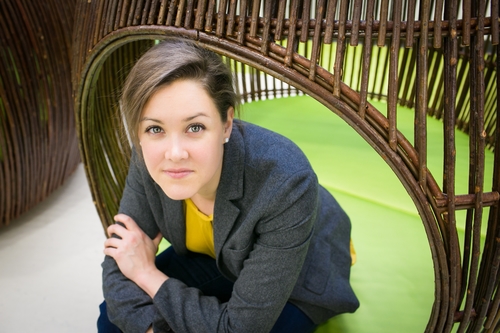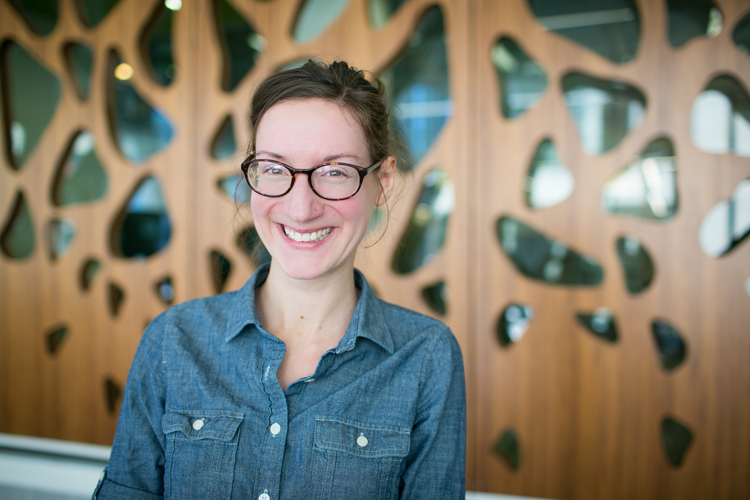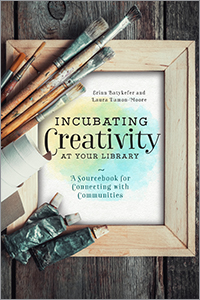Incubating creativity: an interview with Erinn Batykefer and Laura Damon-Moore
As technology consultant David Weinberger puts it, “A platform provides resources that lets other people build things.” The library is an ideal platform for creativity; a new book from Erinn Batykefer and Laura Damon-Moore, creators of the Library as Incubator Project, proves it. In Incubating Creativity at Your Library: A Sourcebook for Connecting with Communities, they spotlight intiatives and activities from across the country. We recently talked with them about what creativity is (and isn't), where libraries can fit in, and the concept of platform building.
Could you tell us a little bit about the Library as Incubator Project, such as how it got started and then evolved into the basis for your book?
Erinn Batykefer: The Library as Incubator Project began during our intro to libraries course at the University of Wisconsin Madison, back when we were just baby proto librarians. One of our earliest class conversations centered on how libraries serve the whole community. We talked about how libraries respond to the specific literacy needs of children, how they create access for differently-abled patrons, how one public library might focus on the interests and needs of older adults, and another might have a lot of services for low-income families just based on who lived in the community.  There was a lively discussion that referenced our course readings and the experiences of our classmates, as many of us were already working in the field.
There was a lively discussion that referenced our course readings and the experiences of our classmates, as many of us were already working in the field.
We’re both artists, so naturally, we wondered how libraries serve artists. It was an interesting question for two reasons: one, no one knew the answer — not our professor, not our classmates, and not, apparently, anyone scholarly who studied this stuff — we couldn’t find anything in the literature. And two, depending on how you define “artist,” all of the user groups we had already talked about — kids and seniors, professionals and dilettantes, anyone — also included artists. They were everywhere. Everyone on the planet is creative. It’s an innate human trait that is expressed in dances and paintings and literature, but also in every-day problem solving. Why weren’t we, as budding professionals, considering this massive, all-encompassing group?
So basically, we set out to create a body of literature that would get us an answer. We built a website and started talking to networks of artists, library workers, creatives, and asking them to share their stories of creative work they had produced with the help of the library, programs they ran that made space for creative exploration and learning, and more. Our professors and our program were hugely supportive and allowed us to build independent studies around this work, because it became clear that even if no one had written about it yet, this was a core competency in libraries. Every community had a need to engage creatively and make new information. Our website and social media platforms buzzed with new stories every single week for seven years, and the patterns and best practices we saw in the most successful and innovative stories on the site coalesced into ideas we shared in conferences and webinars, and now, in our book.
Early in the book you write “Creativity isn’t necessarily about making anything. It’s about thinking differently.” What do you mean by that and where do libraries fit in?
Erinn Batykefer: Creativity isn’t about making anything. A lot of people have that fundamental misconception; they say, “Oh, I’m not creative,” because they don’t make anything with their hands in an arts & crafts way. But the stuff people make is just a byproduct of creativity — it isn’t creativity itself. Creativity is literally being able to imagine something that wasn’t there before. Yes, maybe that is some crazy zombie amigurumi doll you crochet by hand while watching The Walking Dead (on a library DVD, of course!), but it could also be something “uncreative” like your business model, or a work process, or a budget, or figuring out how to fit all the groceries and the stroller and the dog crate in the hatchback. If you watch Project Runway, you’ve heard Tim Gunn say smart things about design, and how its function is to solve a problem. How can you use X material to create Y effect? How can you create a dress for a short model to make her look taller? How can you create something elegant and expensive looking on ZERO budget, with literal trash for materials? You make it work. That’s creativity. It’s problem solving. And it makes something new — maybe it’s a dress, or maybe it’s a new and efficient process of doing a boring task that needs to be done. The process isn’t something you can hold in your hands like the dress is, but that doesn’t mean it didn’t take creativity. It wasn’t there before, and then someone said, oh wait, what if we did it like this?
 Creativity — which is inherent in everyone — is the way we as a species make new information, and libraries are all about information. Libraries organize it, make it accessible, and we can create the conditions where it’s turned into something new we can organize and make accessible. When we’re creative, we make connections, processes, things, and we share them, get feedback, try again, make something new. Libraries are integral to this process.
Creativity — which is inherent in everyone — is the way we as a species make new information, and libraries are all about information. Libraries organize it, make it accessible, and we can create the conditions where it’s turned into something new we can organize and make accessible. When we’re creative, we make connections, processes, things, and we share them, get feedback, try again, make something new. Libraries are integral to this process.
Can you offer some tips for getting started with surveying a community’s artistic landscape?
Laura Damon-Moore: As we say in the book, take your time but make time for it. Use your calendar to block off time to work on it. Start with people you know already — people who have been involved with the library in the past as gallery artists; programmers or instructors; people who use library space for their own arts-focused meetings or events. Ask your colleagues and other staff members for their ideas about who to connect with. Once you’ve surveyed these folks, expand your reach to other cultural institutions in your community or region. Set up informal conversations or visits with staff at art centers; community centers; art museums. Introduce yourself to art teachers at the schools. Let them know that you’re interested in familiarizing yourself with the artistic landscape around you, but I recommend not showing up with an agenda or an ask beyond that. Over time you’ll learn about the “rhythm” of the artistic landscape, and if and how the library can be a piece of that landscape. Don’t forget to ask “who else should I talk to?” whenever you meet with someone. Embrace a mix of reaching out to established institutions and organizations, but also individual artists, in order to hear a mix of perspectives.
What are some ways to get library staff involved with and excited about platform building?
Laura Damon-Moore: I think it’s useful to talk about platform building as just a reframing of what the library does already (programs/invitations; access to many kinds of resources; collaborations between the public and staff; and connecting people to other people in the community). Staff from any department can help make connections when you do the community survey. When you’re assembling the different elements of the Creative Library platform, ask people for ideas about what in their work area or division can be included. And involving people across departments does not mean that people need to do extra work or work outside of their position description. Instead, try to encourage staff to collaborate. For example, if a program coordinator would like to explore circulating musical instruments to expand on a partnership or popular invitation, that exploration can — and should — happen in collaboration with collection management folks, technical services staff, and circulation staff. Even if it takes more time overall, having the process done the correct and most efficient way the first time is obviously more sustainable and creates a healthier work environment between teams and departments.
 Was there an initiative or partnership included in the book that you found especially innovative or surprising?
Was there an initiative or partnership included in the book that you found especially innovative or surprising?
Laura Damon-Moore: We’re always impressed by initiatives where there’s really intentional partnerships happening between libraries and community partners. And as a librarian, there’s nothing that I personally love more than when an artist creates something new out of or inspired by library collections. So I guess some of my personal favorites would be the Edinburgh Art Trail, which we’ve highlighted and talked about many times, and the Look Here! Initiative by the UW-Milwaukee Libraries. Both of those examples demonstrate solid partnerships with other institutions and with individual artists, and this amazing process of research and making something new from the information that has been collected and organized over many years.
Erinn Batykefer: Agreed. I’d also say that the creative problem-solving that went into the Adult Day Camp program at Darien Library was a winner. No, it’s not particularly arts-focused, but the way it approaches the problem of building community for young professionals is very interesting. I think the problem-solving model of that initiative is very applicable in other contexts.
Learn more at the ALA Store.
